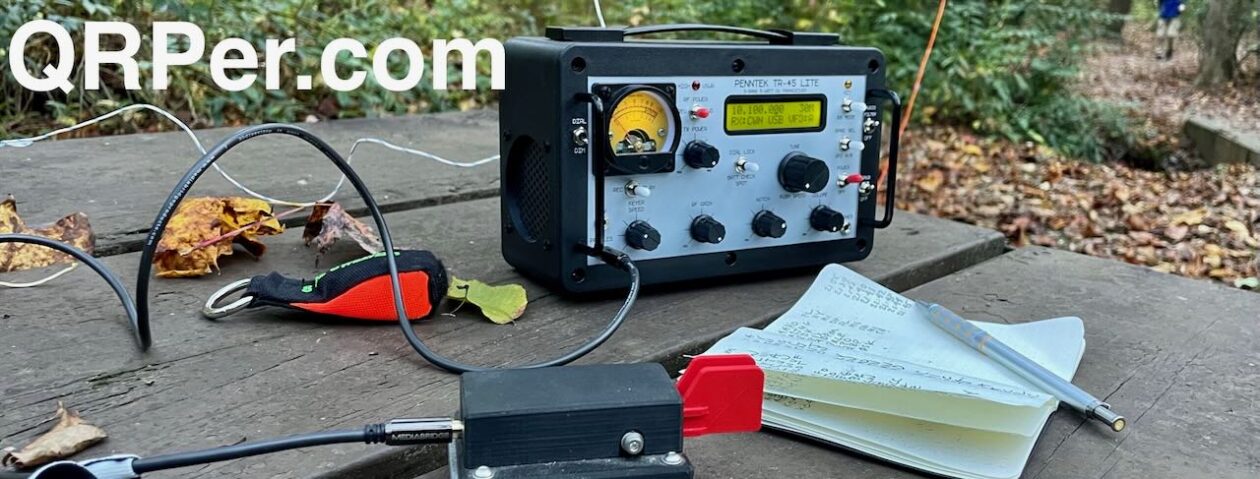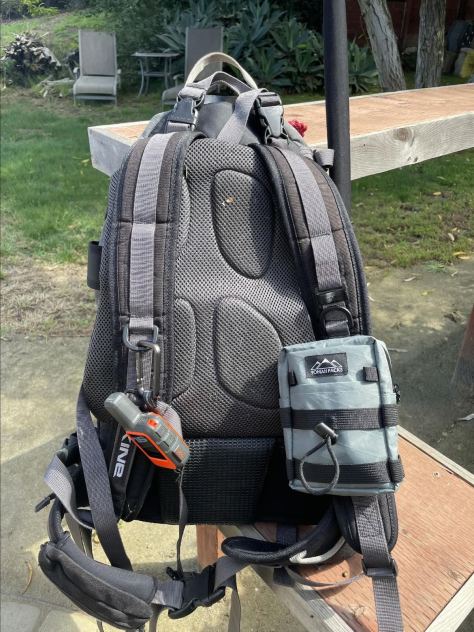Many thanks to Jim (KI7URL) who shares the following article about his portable field radio kit which will be featured on our Field Kit Gallery page. If you would like to share your field kit with the QRPer community, read this post. Jim writes:
(tr)USDx Ultralight Portable Kit
by Jim (KI7URL)
I like to take amateur radio with me wherever I go. In my backpack, I keep a Yaesu FT-60 (powered by 18650 batteries, but that is a different discussion). But I do not like to limit myself to VHF/UHF.
My wife, on the other hand, does not think my “go bag” should take up a significant portion of our suitcase when we travel. I did build a slimmed-down go kit with my Yaesu 891, but that was still north of 12 pounds (vetoed by Wife). Then, I made a go kit with my Yaesu 818, but that was still near the 10-pound zone (again, vetoed). I needed a slimmer package.
I turned to the likes of the QCX mini or other CW-only radios. The problem is that I still am far from proficient with my code, so relying only on CW was a bit more frustrating than I wanted it to be. The (tr)USDx, an open-source radio about the size of two stacked decks of cards, interested me in both price point and functionality. It has SSB, CW, and digital capabilities….on five different bands! Once it was in my hands, I had to build a kit around this new radio!
I want to keep my radio protected, so I started with a small dry box. On the inside, I printed a ‘redneck laminated’ (see also: packing taped) a quick setup guide for using the radio on digital modes if I ever have an in-field case of “the dumb.”
 The radio is powered by a small RC battery. I chose this for size, weight, and availability (had it lying around from another project). When fully charged, it reads 12.6 volts. I added powerpole connectors to it because who does love powerpoles (be careful not to short the battery when adding power poles)? I have a small power adapter that goes from powerpoles to the 1.3mm connector so I can use my bench supply or other power sources without making another cable.
The radio is powered by a small RC battery. I chose this for size, weight, and availability (had it lying around from another project). When fully charged, it reads 12.6 volts. I added powerpole connectors to it because who does love powerpoles (be careful not to short the battery when adding power poles)? I have a small power adapter that goes from powerpoles to the 1.3mm connector so I can use my bench supply or other power sources without making another cable.
I have two antennas that I use (a K6ARK end fed and a QRP Guys No-Tune end fed with 26 gauge wire for 20m). But I like the QRP Guys one because I mostly do 20m and I think it was slightly lighter than the K6ARK antenna (don’t quote me on that though, I loaned the K6ARK one out and have not gotten it back). Plus, not having a tuner lightens my load as well!

I have a retired smartphone in my kit that I use for some logging and some other ham-related apps, but mostly for FT8 using the FT8CN app. I also have WoAD on there and soon I hope I can get WinLink functionality with a small TNC as per this video by OH8STN. HF WinLink would be a good benefit with a lighter load than packing in a laptop or Raspberry Pi.
The kit weighs in at 2 pounds 6 ounces (just over a kilogram). This could be stripped down if I only did an SSB, Digital, or, gasp, a CW activation. But as it stands, the small form factor and low weight make the wife happy!
73,
Jim
KI7URL
Equipment:
- (tr)USDx Assembled Kit
- (tr)USDx protective cover
- Samsung Galaxy S9
- AKG Headphones that come with the S9
- Survivor Dry Box
- Turnigy 3s 1000mah 11.1V battery
- USB Charger for 3s batteries
- USB wall adapter from an old iPhone
- QRP Guys No Tune End Fed Half Wave
- K6ARK Microphone
- Iambic Paddles
- Retractable 3.5mm TRS cable
- 1.3mm DC Plug
- SMA to SMA Male Jumper
- 10m Dacron line
- TRRS to Mic/Headphone adapter
- Custom Cable (for people like me who sometimes don’t have success with audio over USB)


















































